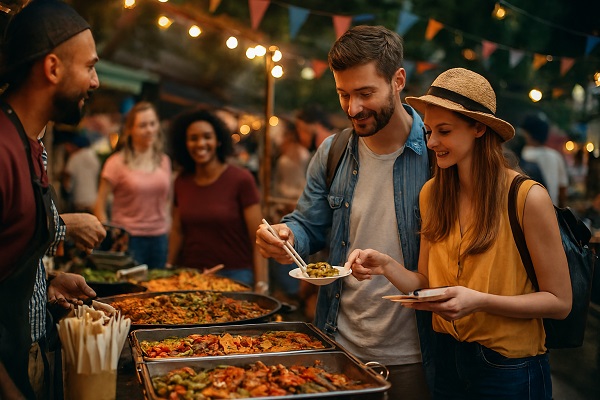Food and Beverage Tourism: Exploring the World Through Flavor

Introduction
Food and beverage tourism is about traveling to experience the unique flavors, traditions, and culinary practices of different regions. It goes beyond eating — it’s about connecting with local culture, history, and people through their food and drink. From street food tours to vineyard tastings, this form of tourism has become a powerful way to discover destinations.
Global Market Trends
The global food tourism market was valued at USD 967.6 billion in 2024 and is projected to grow significantly through 2035.
In India, the culinary tourism market is expected to reach USD 58.6 billion by 2035, growing at a CAGR of 15.6%.
The World Food Travel Association’s 2024 State of the Industry Report highlights key trends: authenticity, localism, sustainability, diversity, AI-driven personalization, and the influence of social media.
Why Food and Beverage Tourism Matters
Cultural Connection: Food reflects traditions, values, and history.
Economic Impact: Culinary tourism supports local farmers, chefs, and artisans.
Sustainability: Promotes farm-to-table practices and eco-friendly dining.
Memorable Experiences: Cooking classes, wine tours, and street food adventures create lasting impressions.
Popular Experiences
Street Food Tours: Bangkok, Mexico City, and Delhi are famous for vibrant street food scenes.
Wine & Brewery Trails: Napa Valley (USA), Bordeaux (France), and Tuscany (Italy).
Cooking Classes: Learn pasta-making in Italy, sushi in Japan, or spice blending in India.
Food Festivals: Oktoberfest in Germany, La Tomatina in Spain, and Mango Festivals in India.
Types of Food Tourists
Gourmet Travelers: Seek fine dining and Michelin-starred restaurants.
Cultural Explorers: Focus on traditional and authentic local dishes.
Adventure Eaters: Try unusual or exotic foods.
Wellness Seekers: Interested in organic, plant-based, or health-focused cuisine.
Challenges
Over-commercialization: Authenticity can be diluted by tourist demand.
Accessibility: Not all destinations have infrastructure for culinary tourism.
Health & Safety: Food hygiene and dietary restrictions must be considered.
Conclusion
Food and beverage tourism is more than tasting dishes — it’s about savoring stories, traditions, and identities. As travelers increasingly seek authentic and sustainable experiences, culinary tourism will continue to grow as a vital part of global travel.
























